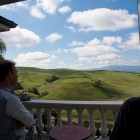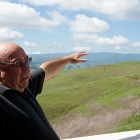From his stone-colonnade balcony, Don Herd sees how San Jose used to look before strip malls and tract homes gobbled up 175 square miles of ridgelines and valley. Cows and Tule elk, green hills and scattered oaks.
The aging temp agency CEO built his hilltop home in 1999 on the city’s southeastern edge amongst a cluster of multimillion-dollar customs marked by Grecian balustrades, marble lions and flanked by manicured palm trees.
It’s the kind of development voters and contemporary policymakers want to avoid, a relic of the Dot Com boom’s indulgent opulence and the single-family housing explosion that turned Silicon Valley into a pell-mell of hillside-breaching sprawl.
But foreign investors are eyeing the nearby hills for another upscale neighborhood, albeit one that’s less dense and with larger units.
“We could lose this,” Herd says, pointing to the stretch of verdant green rangeland between Silver Creek Valley and Metcalfe roads. “This could get replaced with a construction site. After we built our homes here, we decided—the voters decided—that this was it. This is the urban growth line.”
The calm, bucolic setting belies the pitched battle over its future. Hong Kong-based millionaires who own the land want to turn it into a 79-home luxury subdivision, called Young Ranch, with a community center and a nature preserve. But conservationists argue that the 2,150 acres pegged for development lie just beyond a voter-approved boundary called the greenline, which prohibits urban growth. By Tuesday, an online petition opposing the project garnered 560 signatures.
“We want to make sure that the right development happens in the right place,” says Michele Beasley, a regional director at nonprofit Greenbelt Alliance. “This is not the right development nor the right place. It would bring urban services to a rural area.”
Beasley and others say the property owners seem out of touch with what the community wants for its remaining countryside, an ecologically sensitive expanse of serpentine grassland, ponds, creeks and intermittent streams. “This land, the way it is, actually contributes to our quality of life,” she says. “When you have protected hillsides, that’s our watershed land, that’s the land that filters our drinking water.”
The landholding company YCS Investments, short for the family name Yeung Chi Shing, bought up the land in the 1970s. They waited decades before filing initial permits for the $90 million project with Santa Clara County four years ago.
“There were other plans and efforts for the property that came up over the years, but none of them were successful or got past very early stages of planning,” says Wayne Costa, a senior project manager for YCS Investments. “The current effort started to take shape in 2010 after the economy started emerging from the Great Recession.”
But while the owners held off development for nearly 40 years, the region underwent a culture change in the way it approaches urban planning. Runaway growth led to congested roadways and the backlash prompted voters and policymakers to favor infill over spread-out construction. Measure K, which established the greenline just beyond Herd’s home in 2000, passed with 81 percent of the vote.
The latest iteration of the city’s General Plan—its blueprint for growth—calls for denser housing within walking distance to jobs and public transit.
“This just isn’t the type of development we want anymore,” says Julie Hutcheson, an advocate for Committee for Green Foothills, another group protesting Young Ranch. “It depends on which side of the fence you’re standing. County staff reportedly believes they have a viable project here. Whereas the city of San Jose thinks, hey, this doesn’t match up to what we have in our general plan. There’s a conflict of jurisdictions.”
Meanwhile, the region formed what became the Habitat Conservation Plan, a public-private permitting framework that promises to protect 60 percent of the county’s remaining wild land, raise $658 million for conservation and protect 18 endangered and threatened species. Under the new guidelines, YCS Investments would have to dedicate 90 percent of the land as a nature preserve. The company turned that into a marketing opportunity, revamping their website to include photos of rolling hills, roaming cattle and butterflies and boasting of its stewardship of the land.
“Through our habitat plan work we began to realize the contribution we could make and saw an opportunity to be one of the first private proposals that could be a model for private rural development that facilitates the creation of the Habitat Plan’s reserve system,” says Costa, whose original proposal included 87 homes and a community center.
The application up for review by county planning commissioners would build Young Ranch in two phases: 39 homes at first, the rest following later approval. It would need San Jose to relinquish two-thirds of the parcel to the county. The homes would lie on two-acre plots in the northernmost 200 acres of the property and be held to strict landscaping rules to maintain a rural feel.
No lots would be flattened, no sidewalks paved and no boundary fences erected. Homeowners would rely on septic tanks and water would come from either wells or the privately owned Edenvale/Great Oaks Water Service. A 3-mile-long access road to the development would branch off from Silver Creek Valley.
“It comes down to how you define rural,” says Herd, who says he grew up in the Kansas countryside before striking it rich in California. “Where I’m from you have one house per 10 acres or more. That’s real rural.”
A neighborhood the size of Young Ranch would strain public services and infrastructure, says John Baty, a senior planner for the city of San Jose.
It would likely depend on the city for fire protection, police services and add traffic to existing roadways. San Jose planning commissioners would also have to agree to annex two-thirds of the property from city jurisdiction to the county to proceed with development, giving up revenue from construction fees.
“This is, by far, the county’s biggest housing proposal in years,” Beasley says. “We just don’t see this type of project anymore. It’s pretty well documented that we have overbuilt the single-family home market.”
On April 24, the county Planning Commission will hold a fourth hearing on the matter to discuss whether the application complies with the general plan’s vision for unincorporated development.
Costa insists that it does. “A lot of people are under the impression that if you’re outside the urban growth boundary, that means zero development,” he says. “Right now, they’re seeing rolling green hills with cows grazing and they think that it’s public open space. It’s not. It’s private land where we’re allowed to have what we call rural-residential development up to a certain density.”
Costa says environmental groups seem to disregard the fact that his company has managed the land responsibly and wants to protect the vast majority of it.
“We’re not just trying to build a run-of-the-mill development,” he says. “We’re trying to create a conservation community. The first step to that is to know your property. We studied the land—we studied its resources and habitat—and then designed the development portion of it as sensitively as possible.”
Beasley dramatically likens Costa’s approach to a hostage situation.
“It’s as if they have a gun to our head,” she says.
“They want to do a trade-off to hand over this land to habitat conservation in exchange for development approval. But this shouldn’t be a trade-off. We have to look at whether this fits the spirit and intent of the growth boundary.”
- John Leggio and Don Herd overlook the hills in San Jose’s south Evergreen district.
- Don Herd built his Silver Creek home in 1999, a year before voters approved Measure K.
- John Leggio, a Silver Creek resident, signed a petition opposing development in San Jose’s southern hillsides.





Thanks SJI. We used to read about important issues in the Mercury News but they have no real interest in reporting on San Jose anymore. The local print edition of the Mercury New is little more than reprints from the Palo Alto Daily and other BANG papers.
When the City first announced it’s general plan, we the people understood that it would be something of a compromise. We would tolerate the congestion and suppression of our property values eventuating from aggressive zoning allowances promoting high density infilling. In exchange we could expect that the zoning in the foothills and in Coyote Valley would remain mostly static thus preserving the rural character beyond the “greenbelt”. Landbuying speculators should have had no expectation of wildly increasing land valuations because, publicly anyway, there was no expectation that subdividing would ever be allowed.
This whole scenario could be right out of an Ayn Rand novel. Liberal government, acting under the guise of environmentalism, makes solemn promise to preserve environment. Then, when liberal government finds it more politically advantageous to appease powerful, moneyed interests, liberal government suddenly forgets original environmentalism excuse.
Ayn Rand’s Galt was all about personal responsibility- not anarchy. He’d have expected local government officials to work on behalf of their constituency rather than on behalf of special interests. Local governments DO have power and responsibilities that need to be exercised honestly, responsibly, and above all consistently. Try actually reading “Atlas Shrugged” Neil rather than automatically buying into the drivel spouted off by your liberal friends.
John G just which Neil are you replying to?
Anyway, the high density Urban Village concept is a fail. Yes, you pack rats closely near a public transit site, but the idea that jobs are nearby in the ‘village’ that would support any resident, are ludicrous. To ameliorate traffic congestion, employers should be spreading out, not workers crowding in. If San Jose and ABAG were serious, they would coordinate ‘incentives’ for tech employers to *build and locate* in Coyote, Morgan Hill and Gilroy. There will never be traffic relief until employers stop *their* high density infilling. San Jose’s misguided Urban Village concept [up to 70 of them!] results in Santana Row replicas with their own local traffic congestion nightmares. Cheers
Oh there was a guy named Neil that chimed in on an article posted here 2 days ago called “City Considers Moratorium on Mobile Home Park Conversions”. He seemed to think there was some inconsistency between what I wrote and the handle I go by. And you’re right about these ridiculous “urban villages”. Cars parked all up and down the streets owned by people who supposedly take public transit everywhere. The arrogance and egos possessed by these social engineer ABAG utopians who foist this crap on us is simply breathtaking.
These Silver Creek residents are so hypocritical. They exude an air of moral certitude – “Do what I say, not as I do.” They pride themselves on being selflessly committed to the highest ideals of protectionism and rural land use while seeming particularly confident of the purity of their motives and the evil nature of their neighboring land owners. To correct economic and development injustice, all while passing judgement from their extravagant, palatial $2M – $4M single family homes.
What a huge contradiction! John Leggio and Don Herd are the ultimate hypocrites. Conveniently, these homeowners adopt this new viewpoint now that Young’s Ranch “threatening their views,” but when it comes to what matters most in their own lives—their property and their privacy—they jettison their principles and embrace ones that are self-serving. This is disgusting. Shame on them – I say YCS should build their homes right against their lots!
I tend to agree with CILSJ — once people are owners in the market, the natural tendency is to do everything possible to stop further development in order to increase their own property values. Take a read of this very thorough article on the dynamics that are driving property values through the roof in SF and the peninsula: http://techcrunch.com/2014/04/14/sf-housing/
Ironically, on September 11th of last year I attended a discussion panel about this proposal. We were told that the owners used the land for cow grazing, but can no longer afford it and they want to turn it into an “eco” development project. They said it’s a home to endangered butterfly and they are going to “preserve” it if they build… HOW??? They said it’s only 10% of the land, but when they showed the plan it was more like 50% because it’s all spread out. They also failed to mention those are foreign Chinese owners and there are 17 more endangered spices on that land…
Chinese are buying property and land all-over, not just in California or US, but all over the World. I was told by many realtors that recent artificial real estate inflation is due to Chinese cash buyers. Think of the Bundy ranch ordeal and much more you have not heard yet, or connected yet. Something to think about…